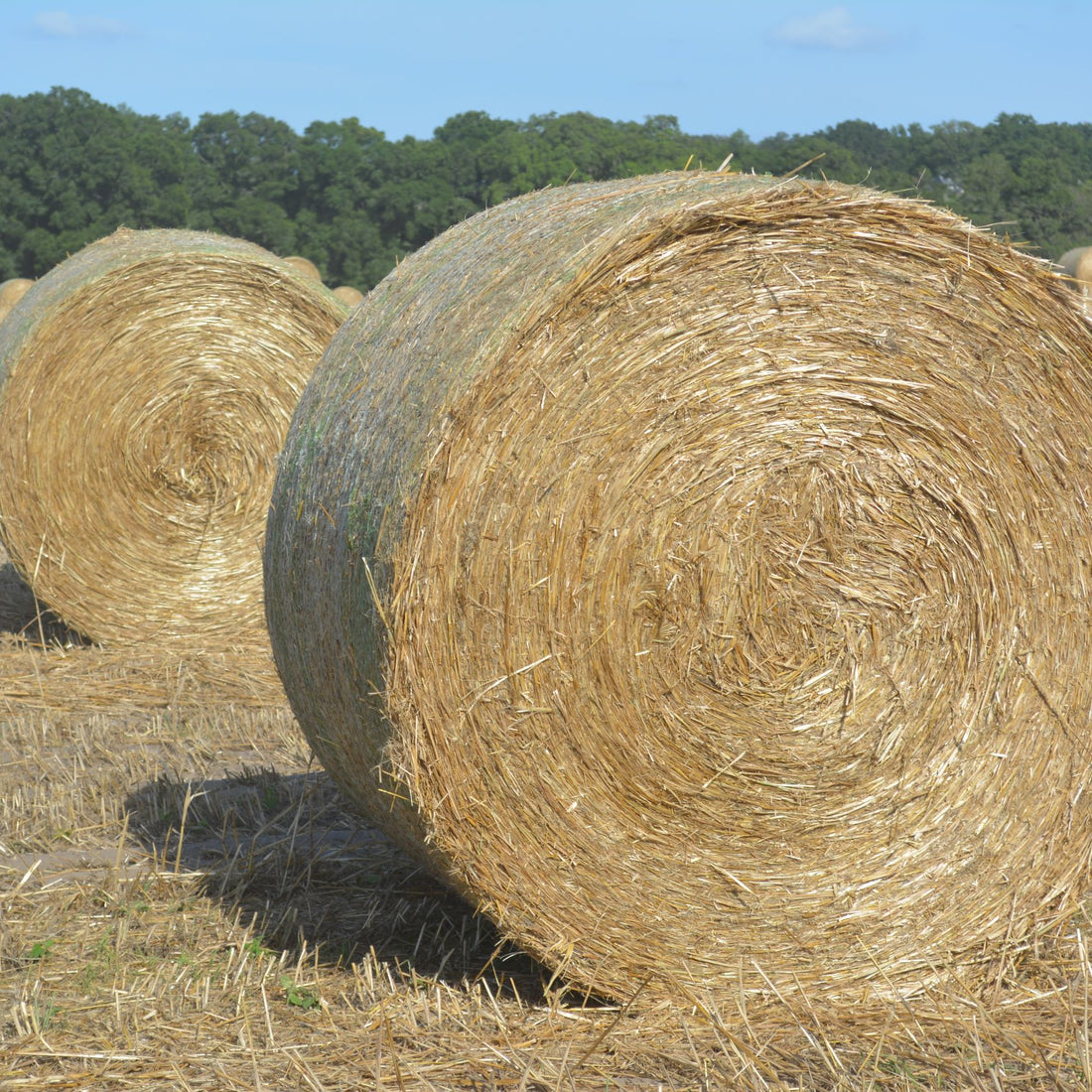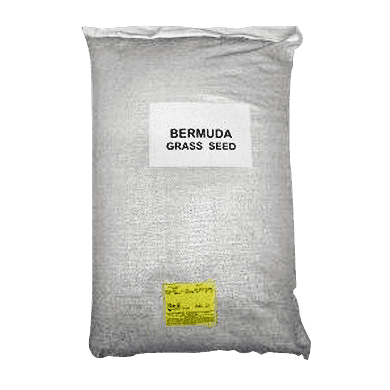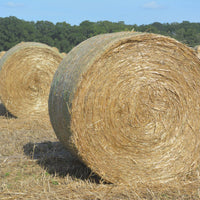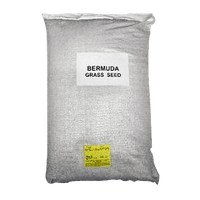
- When to plant:
- Spring, Summer
- Fertilizer:
- Hancock's 16-04-08 Lawn & Pasture Fertilizer
- Seeding rate:
- 5 - 10 lbs. per acre
- Overseeding rate:
- 5 lbs. per acre
- Seeding depth:
- 1/8 - 1/4 inch
- Ideal ph:
- 5.5 - 6.8
- Gmo:
- No
- Inoculant needed:
- No
- Coated or raw:
- Raw
- Lifecycle:
- Perennial
- Climate zones:
- Transition Zone, Warm Season
Giant Bermuda grass is similar in appearance and nutrition to coastal Bermuda grass. Giant Bermuda is a tall growing aggressive bermuda species that spreads by crawling runners and rhizomes.
Product Information
- Application or Use: Pasture, Cattle Grazing, Livestock Forage, Cover Crop, Hay Production
- Germination Time: 5 - 12 days, under optimal conditions
- Growing Locations: Warm Season & Transition Zone
- Height: Grazing or Hay Cutting, 8 - 10 inches
- Sunlight Requirements: 8+ hours, full sun for best results
- Advantages: Able to withstand heavy grazing pressure and weather extremes; high protein content.
- When to Plant: Recommended planting time is spring and summer when nighttime temperatures are consistently 65+ degrees and 3 months prior to first frost.
Product Details
- Average of 30 inches in height
- Can harvest 4 to 5 times per year for hay production, if properly managed
- Great for cattle forage, hay production, and pasture applications
- Feeding value equal to alfalfa in terms of total digestible nutrients (TDN)
- Produces excellent hay production in spring, summer and early fall
Product Information
Giant Bermuda has shown an average of 30 inches in height compared to common varieties at 14-16 inches. For hay production, Giant Bermuda can be harvested 4 to 5 times per year if properly managed. Giant Bermudagrass is used for cattle forage, hay production, and pasture applications. Giant Bermuda grass seed produces excellent hay production in spring, summer and early fall.
Bermudagrass is suited for commercial pasture or hay production in areas where (1) land and water costs are relatively low, (2) total soluble salts in water tend to restrict production of other crops, and (3) bermudagrass is also a practical choice for small pasture plots where a home owner wants to keep one or two horses and or pasture a few cattle.
Bermudagrass normally can be pastured or harvested from mid-April until frost time in November. Over this seven-month period, a planting generally can carry one to two horses, 2 to 5 head of 400 to 600 pound beef cattle, or 2 to 3 cows and calves per acre. Growing cattle will gain about 1/2 to 1 pound per day, if no additional feed is provided. Hay yields run from 5 to 10 tons per acre a season, harvested in about 6 cuttings. When properly fertilized, irrigated and harvested, bermudagrass hay has a feeding value about equal to alfalfa hay in terms of total digestible nutrients (TDN), but has less digestible protein.
*Product packaging may appear different than what is pictured.
Establishing a Stand
To establish a stand, broadcast the seed at a rate of 10 to 20 pounds per acre. Or seed can be drilled in 20-inch rows with vegetable planting equipment at the rate of 10 pounds per acre. When drilling, it is best to plant in dry seed bed and irrigate-up, unless the soil is disked first to kill germinated weed seed.
Planting depth is extremely important. For best results seed should be planted as near 1/4 inch deep as possible. Do not plant too deep. It is a good practice to apply a light irrigation (or after planting in a moist seedbed). This keeps the soil from crusting and the seed moist. It will be about 90 days from date of planting until first harvest. Do not mow or graze closer than 1-1/2 inches during the first 2 or 3 harvests.
Fertilization: Bermudagrass is a heavy and efficient user of nitrogen. Up to 300 pounds of actual nitrogen per acre per year can be used. This should be applied 3 to 4 uniform application of 75 to 80 pounds per acre. The first application should be made in early March as the grass begins to turn green, and the last application in late August or early September.
Irrigation: The water requirements of bermudagrass will vary slightly from one year to the next an from one area to another, but a total of 5 to 6 acre feet of water per acre per year is needed.
When choosing to start a new lawn, remove old vegetation by using a de-thatcher, power rake or tiller to kill the existing vegetation. Rake or drag the area to remove debris and dead grass for a clean area. Ensure the soil is leveled and loosened to allow the seed to have good soil contact once spread on a clean seed bed.
If you have an area with heavy weed coverage, we recommend starting fresh by killing and removing the existing vegetation. If you choose to use chemicals, herbicides or fertilizers, you must check with the product's manufacturer prior to planting new seed to ensure the proper waiting period.
When overseeding an existing area, mow your lawn at the lowest setting and bag the clippingsx. Rake or drag any areas that have dead thatch or debris.

Seed Quality
Hancock Seed is dedicated to delivering the best seeds possible to our customers. Hancock Seed grows and harvests many of our products, and we acquire the majority of the rest from other family farmers.
All these seeds are processed, packaged and shipped from Hancock Farm. This helps us ensure that our high standards are met. Unlike much of the competition, we refuse to sell you a seed that was not gathered during the last harvest. You will always receive fresh product from Hancock.
Every seed we grow comes with 40 years of experience behind it...you can rest assured that all of our products are cultivated in a method that assures its potential for growth.

Your cart ( 0 )

Giant Bermuda grass is similar in appearance and nutrition to coastal Bermuda grass. Giant Bermuda is a tall growing aggressive bermuda species that spreads by crawling runners and rhizomes.
Product Information
- Application or Use: Pasture, Cattle Grazing, Livestock Forage, Cover Crop, Hay Production
- Germination Time: 5 - 12 days, under optimal conditions
- Growing Locations: Warm Season & Transition Zone
- Height: Grazing or Hay Cutting, 8 - 10 inches
- Sunlight Requirements: 8+ hours, full sun for best results
- Advantages: Able to withstand heavy grazing pressure and weather extremes; high protein content.
- When to Plant: Recommended planting time is spring and summer when nighttime temperatures are consistently 65+ degrees and 3 months prior to first frost.
Product Details
- Average of 30 inches in height
- Can harvest 4 to 5 times per year for hay production, if properly managed
- Great for cattle forage, hay production, and pasture applications
- Feeding value equal to alfalfa in terms of total digestible nutrients (TDN)
- Produces excellent hay production in spring, summer and early fall
Product Information
Giant Bermuda has shown an average of 30 inches in height compared to common varieties at 14-16 inches. For hay production, Giant Bermuda can be harvested 4 to 5 times per year if properly managed. Giant Bermudagrass is used for cattle forage, hay production, and pasture applications. Giant Bermuda grass seed produces excellent hay production in spring, summer and early fall.
Bermudagrass is suited for commercial pasture or hay production in areas where (1) land and water costs are relatively low, (2) total soluble salts in water tend to restrict production of other crops, and (3) bermudagrass is also a practical choice for small pasture plots where a home owner wants to keep one or two horses and or pasture a few cattle.
Bermudagrass normally can be pastured or harvested from mid-April until frost time in November. Over this seven-month period, a planting generally can carry one to two horses, 2 to 5 head of 400 to 600 pound beef cattle, or 2 to 3 cows and calves per acre. Growing cattle will gain about 1/2 to 1 pound per day, if no additional feed is provided. Hay yields run from 5 to 10 tons per acre a season, harvested in about 6 cuttings. When properly fertilized, irrigated and harvested, bermudagrass hay has a feeding value about equal to alfalfa hay in terms of total digestible nutrients (TDN), but has less digestible protein.
*Product packaging may appear different than what is pictured.
Establishing a Stand
To establish a stand, broadcast the seed at a rate of 10 to 20 pounds per acre. Or seed can be drilled in 20-inch rows with vegetable planting equipment at the rate of 10 pounds per acre. When drilling, it is best to plant in dry seed bed and irrigate-up, unless the soil is disked first to kill germinated weed seed.
Planting depth is extremely important. For best results seed should be planted as near 1/4 inch deep as possible. Do not plant too deep. It is a good practice to apply a light irrigation (or after planting in a moist seedbed). This keeps the soil from crusting and the seed moist. It will be about 90 days from date of planting until first harvest. Do not mow or graze closer than 1-1/2 inches during the first 2 or 3 harvests.
Fertilization: Bermudagrass is a heavy and efficient user of nitrogen. Up to 300 pounds of actual nitrogen per acre per year can be used. This should be applied 3 to 4 uniform application of 75 to 80 pounds per acre. The first application should be made in early March as the grass begins to turn green, and the last application in late August or early September.
Irrigation: The water requirements of bermudagrass will vary slightly from one year to the next an from one area to another, but a total of 5 to 6 acre feet of water per acre per year is needed.
Instructions
When choosing to start a new lawn, remove old vegetation by using a de-thatcher, power rake or tiller to kill the existing vegetation. Rake or drag the area to remove debris and dead grass for a clean area. Ensure the soil is leveled and loosened to allow the seed to have good soil contact once spread on a clean seed bed.
If you have an area with heavy weed coverage, we recommend starting fresh by killing and removing the existing vegetation. If you choose to use chemicals, herbicides or fertilizers, you must check with the product's manufacturer prior to planting new seed to ensure the proper waiting period.
When overseeding an existing area, mow your lawn at the lowest setting and bag the clippingsx. Rake or drag any areas that have dead thatch or debris.


















